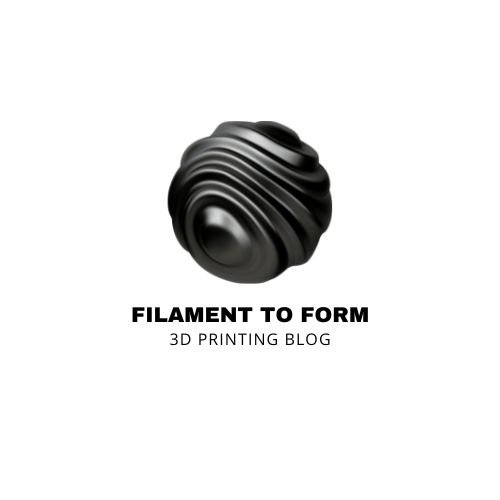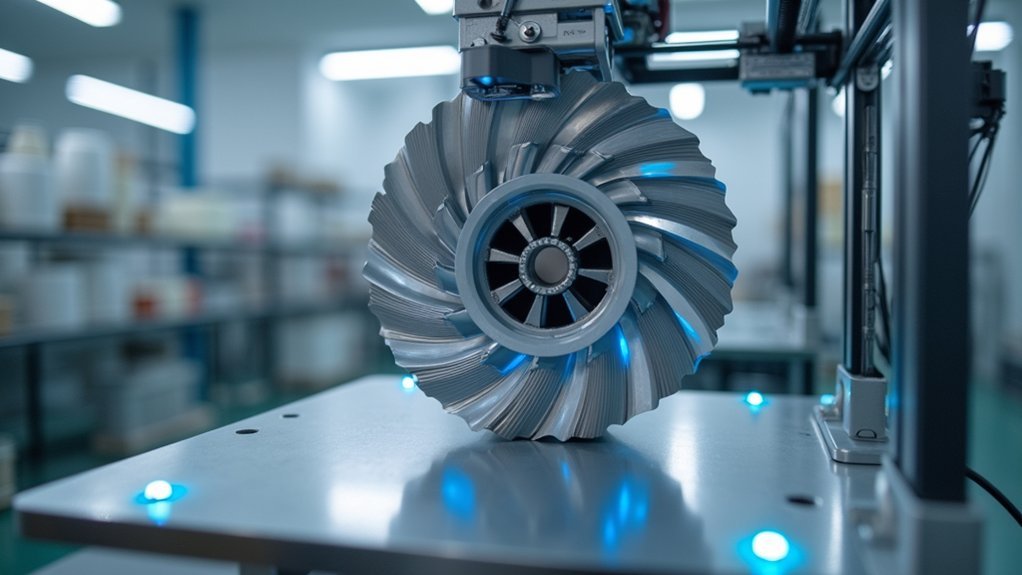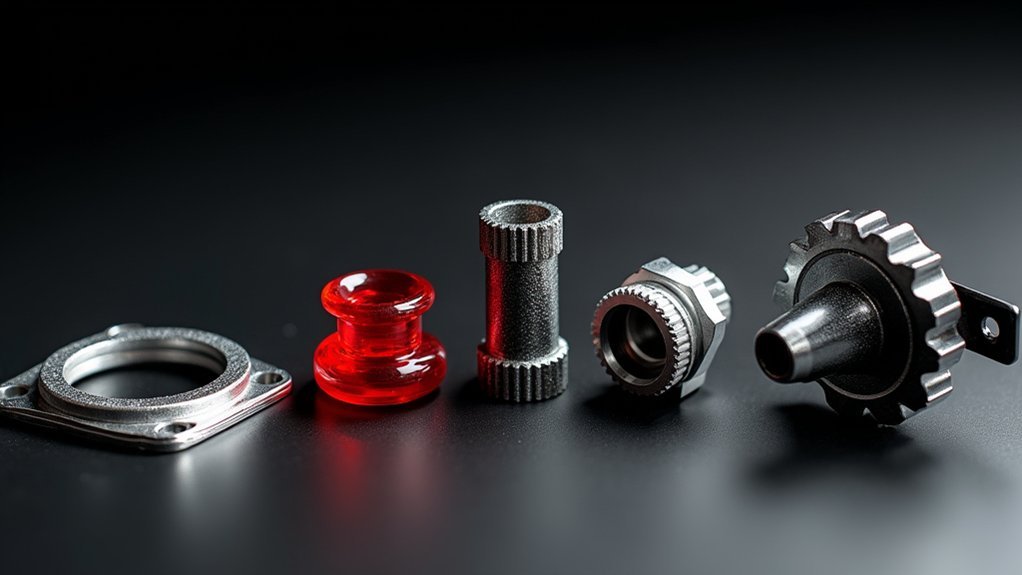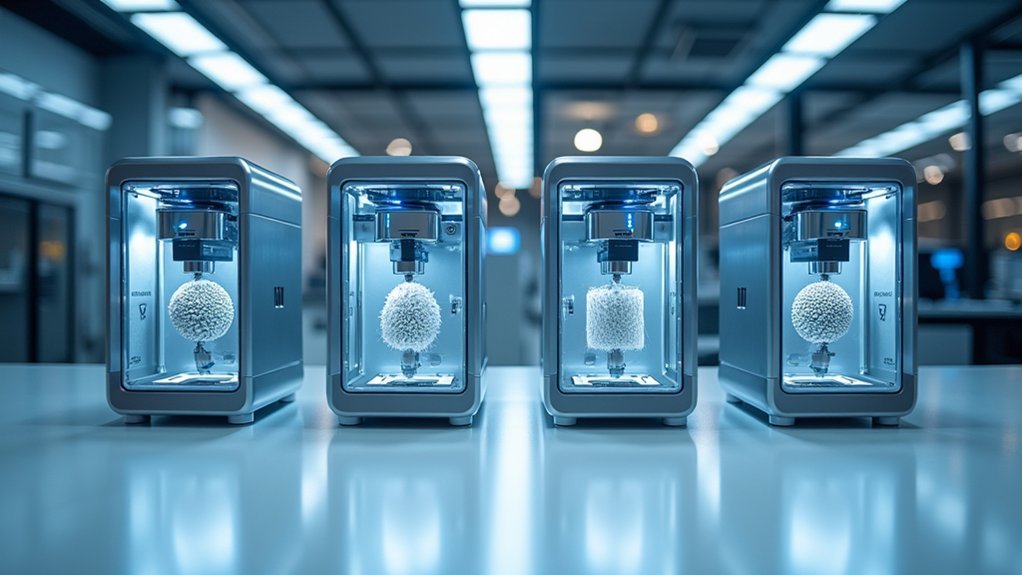You’re facing critical decisions that’ll determine whether your aerospace 3D printing projects meet stringent industry standards or fall short of certification requirements. The materials and equipment you choose in 2025 must withstand extreme temperatures, mechanical stress, and regulatory scrutiny that can make or break multi-million dollar aerospace programs. These ten selections represent the cutting-edge solutions that experienced engineers trust when failure isn’t an option.
Polymaker Fiberon PPS-CF Filament Black 1.75mm 0.5kg
If you’re developing aerospace components that must withstand extreme thermal conditions, the Polymaker Fiberon PPS-CF Filament delivers exceptional heat resistance above 250°C while maintaining structural integrity. This carbon fiber-reinforced filament meets UL94 V0 flame retardancy standards, making it ideal for critical aerospace applications.
You’ll appreciate its superior print quality, which prevents warping, jamming, and layer delamination while ensuring excellent bed adhesion. The 1.75mm diameter provides precise dimensional accuracy for demanding specifications. The filament’s vacuum-sealed packaging with desiccant maintains material integrity, while the recycled cardboard spool prevents contamination and tangling during storage.
Best For: Aerospace engineers and advanced manufacturers who need high-temperature resistant components that can withstand extreme thermal conditions above 250°C while maintaining structural integrity and flame retardancy standards.
Pros:
- Exceptional heat resistance above 250°C with UL94 V0 flame retardancy standards for critical applications
- Superior print quality with excellent layer adhesion that prevents warping, jamming, and delamination
- Carbon fiber reinforcement provides enhanced rigidity and structural strength for demanding specifications
Cons:
- Higher cost compared to standard 3D printing filaments due to advanced composite materials
- Requires specialized printing equipment capable of handling high-performance materials and elevated temperatures
- Smaller 0.5kg spool size may require frequent replacements for large-scale projects
The Zombie Apocalypse Guide to 3D Printing: Designing and Printing Practical Objects
When you’re searching for a thorough introduction to 3D printing that combines technical expertise with engaging, approachable content, “The Zombie Apocalypse Guide to 3D Printing: Designing and Printing Practical Objects” stands out as an exceptional choice for beginners and hobbyists seeking practical applications. You’ll find expert guidance on optimizing prints for speed and strength, debugging printer issues, and designing replacement parts. The book’s humor makes technical concepts less intimidating while maintaining practical focus on disaster preparedness scenarios. Though some find the zombie theme distracting, you’ll appreciate the extensive appendices and clear advice that make this a valuable handbook.
Best For: Beginners and hobbyists who want a comprehensive introduction to 3D printing with practical applications and engaging, humor-filled content that makes technical concepts accessible.
Pros:
- Combines expert technical guidance on optimizing prints, debugging issues, and designing replacement parts with beginner-friendly explanations
- Uses humor throughout to make intimidating technical concepts more approachable and engaging
- Includes extensive appendices with practical examples and applications that enhance its value as a reference handbook
Cons:
- The zombie apocalypse theme may distract from the serious technical content for some readers
- Content overlaps significantly with the author’s other book, creating potential redundancy for those purchasing both
- Some chapters like compliant mechanics may be less relevant or useful to the target audience
YXPOLYER PC-CF Filament Polycarbonate Carbon Fiber 1.75mm 1kg
Professional engineers and manufacturers demanding exceptional strength-to-weight ratios will find YXPOLYER PC-CF Filament to be a game-changer for aerospace applications. You’ll get superior tensile and flexural strength from its 15% chopped carbon fiber reinforcement while maintaining lightweight properties essential for flight components. The material’s outstanding thermal stability withstands extreme temperatures you’ll encounter in aerospace environments. You’ll achieve excellent shape stability and mechanical durability under stress, plus significant chemical and abrasion resistance for long-lasting parts. The filament delivers low warping and excellent layer adhesion, ensuring consistent dimensional accuracy you need for critical aerospace components requiring both strength and precision manufacturing.
Best For: Professional engineers and manufacturers in aerospace, automotive, and industrial applications who need high-strength, lightweight components with exceptional heat resistance and dimensional accuracy.
Pros:
- Superior strength-to-weight ratio with 15% carbon fiber reinforcement ideal for demanding applications
- Outstanding thermal stability and heat resistance suitable for extreme temperature environments
- Excellent printing performance with low warping and consistent dimensional accuracy for precision parts
Cons:
- Higher cost compared to standard filaments due to carbon fiber reinforcement
- Requires heated bed and enclosure for optimal printing results
- Can be abrasive to printer nozzles, potentially requiring hardened steel or ruby-tipped nozzles
ELEGOO PC Filament 1.75mm Clear Black 1KG for 3D Printing
The ELEGOO PC Filament delivers exceptional impact resistance and mechanical performance that makes it an ideal choice for engineers and designers creating functional prototypes requiring aerospace-grade durability. You’ll appreciate its polycarbonate construction that withstands demanding applications while maintaining dimensional accuracy within ±0.05mm tolerance. The 1.75mm clear black filament requires an enclosed printer and benefits from pre-drying at 80°C for eight hours to prevent moisture issues. You’ll experience minimal warping and excellent first-layer adhesion, though you’ll need to manage higher printing temperatures. The vacuum-sealed packaging protects against moisture and tangling during storage.
Best For: Engineers, designers, and advanced 3D printing enthusiasts who need aerospace-grade durability and exceptional impact resistance for functional prototypes and demanding applications.
Pros:
- Exceptional mechanical performance with high impact resistance ideal for functional parts and prototypes
- Maintains excellent dimensional accuracy within ±0.05mm tolerance for consistent, reliable prints
- Low warping properties and excellent first-layer adhesion enhance print reliability
Cons:
- Requires an enclosed printer and higher printing temperatures, limiting printer compatibility
- Must be pre-dried at 80°C for 8 hours before use to prevent moisture-related printing issues
- More challenging to print compared to standard filaments due to polycarbonate material requirements
FLASHFORGE ABS Pro Filament 1.75mm Burnt Titanium (1kg Spool)
FLASHFORGE’s ABS Pro filament in Burnt Titanium delivers exceptional dimensional accuracy and heat resistance that aerospace engineers demand for critical prototyping applications. You’ll achieve +/-0.02mm precision with 99% size accuracy, while the material withstands temperatures up to 90℃ without deformation. The chameleon series color-changing properties conceal layer lines and create striking visual effects under different lighting conditions. You won’t need pre-drying or parameter adjustments thanks to its remarkable stability. Strong bed adhesion guarantees reliable first layers, while superior bridging performance prevents delamination during complex geometries. Low odor enhances your workspace comfort during extended printing sessions.
Best For: Professional engineers, designers, and makers who need high-precision functional parts with excellent heat resistance and visual appeal for prototyping or complex geometries.
Pros:
- Exceptional dimensional accuracy of +/-0.02mm with 99% size consistency for precision applications
- Superior heat resistance up to 90℃ with reduced warping and cracking compared to standard ABS
- Chameleon color-changing properties that conceal layer lines and create striking visual effects
Cons:
- Higher cost compared to standard ABS or PLA filaments
- Still requires heated bed and proper ventilation despite being low odor
- Limited color availability as part of specialty chameleon series
Siraya Tech Fibreheart PPA-CF Core Black 3D Printer Filament (1kg)
When you’re developing high-stress aerospace components that demand exceptional strength-to-weight ratios, Siraya Tech Fibreheart PPA-CF Core Black filament delivers performance that surpasses traditional materials. This advanced filament features 25% core-concentrated carbon fiber within a Polyphthalamide base, providing superior strength, chemical resistance, and thermal stability compared to standard Nylon.
You’ll appreciate its low moisture absorption, which guarantees consistent performance and reduces warping in humid conditions. The core-concentrated design minimizes fiber exposure, reducing nozzle wear while enhancing print quality. Its improved Z-axis strength creates durable prints suitable for automotive and industrial applications where components face extreme stress and high-temperature environments.
Best For: Engineers, makers, and professionals in aerospace, automotive, and industrial applications who need high-strength, lightweight components that can withstand extreme stress and high-temperature environments.
Pros:
- 25% core-concentrated carbon fiber design provides exceptional strength-to-weight ratio while minimizing nozzle wear and improving print quality
- Superior thermal stability and chemical resistance from advanced Polyphthalamide base material that outperforms traditional Nylon
- Low moisture absorption ensures consistent performance and reduced warping, even in humid conditions
Cons:
- Requires safety precautions including PU gloves when handling printed parts
- Likely demands higher printing temperatures and specialized printer settings compared to standard filaments
- Premium pricing expected for this advanced engineering-grade material
Bambu Lab A1 Mini Combo 3D Printer with AMS Lite
Demanding aerospace applications require both precision and speed, making the Bambu Lab A1 Mini Combo 3D Printer with AMS Lite an exceptional choice for engineers who can’t compromise on quality. You’ll achieve remarkable 10,000 mm/s² acceleration while maintaining exceptional accuracy for detailed aerospace components.
The AMS Lite enables vibrant multi-color prototyping, essential for complex aerospace modeling. You won’t waste time on manual calibration—the full-auto system handles everything automatically. Active flow rate compensation guarantees consistent material delivery for flawless results.
You’ll appreciate the simplified touchscreen interface that gets you operational in just 20 minutes. The 1-Clip quick swap nozzle streamlines maintenance between projects. At ≤48 dB operation, you can work in noise-sensitive environments without disruption.
Best For: Engineers and professionals in aerospace, prototyping, and precision manufacturing who need fast, accurate multi-color 3D printing with minimal setup time and quiet operation.
Pros:
- Exceptional speed and precision with 10,000 mm/s² acceleration while maintaining detailed accuracy
- Full automation features including auto-calibration and active flow rate compensation eliminate manual setup
- Multi-color printing capability with AMS Lite enables complex prototyping and modeling
Cons:
- May be overkill for basic hobbyist printing needs given its professional-grade features
- Requires investment in AMS Lite system for multi-color capabilities if purchased separately
- Compact “Mini” size may limit build volume for larger aerospace components
Certified Food Grade PLA+ 3D Printer Filament by Comfy Materials (Blue)
Food safety engineers and culinary manufacturers requiring aerospace-level precision will find Comfy Materials’ Certified Food Grade PLA+ filament delivers exceptional dimensional accuracy at +/- 0.02mm tolerance. You’ll appreciate the REVODE110 Polylactic Acid resin’s TÜV SÜD and SGS certifications, meeting FDA 21 CFR 175.300 compliance standards. The material’s 35 MPa tensile strength and 190-220°C processing temperature range guarantee consistent extrusion across most FDM printers. You can print food-contact items like precision measurement tools and culinary implements with confidence. The vacuum-sealed packaging with desiccant maintains material integrity, while the low carbon footprint supports sustainable manufacturing practices.
Best For: Food safety engineers, culinary manufacturers, and professional makers who need FDA-compliant 3D printing filament with aerospace-level dimensional accuracy for creating food-contact kitchen tools and precision culinary implements.
Pros:
- FDA 21 CFR 175.300 compliant with TÜV SÜD and SGS certifications ensuring safe food contact applications
- Exceptional dimensional accuracy of +/- 0.02mm tolerance with high tensile strength of 35 MPa for precision printing
- Vacuum-sealed packaging with desiccant maintains material integrity while supporting sustainable manufacturing with low carbon footprint
Cons:
- Some users report layer adhesion challenges requiring adjustments to printing speed and temperature settings
- Requires stainless steel nozzles specifically for maintaining food-grade safety standards
- Higher precision requirements may demand more careful calibration compared to standard PLA filaments
ELEGOO Carbon Fiber PLA Filament 1.75mm Black 1KG for FDM 3D Printers
ELEGOO’s Carbon Fiber PLA Filament delivers exceptional strength-to-weight ratios that make it an outstanding choice for engineers and hobbyists creating lightweight yet durable components for aerospace applications. You’ll appreciate the carbon fiber reinforcement that provides outstanding stiffness and impact resistance for mission-critical parts. The 1.75mm diameter maintains +/- 0.02mm accuracy, ensuring consistent feeding and preventing print failures. You’ll achieve tightly bonded layers with smooth surface finishes and minimal layer lines, perfect for complex aerospace designs. The vacuum-sealed packaging prevents moisture absorption and clogging issues. You’ll need hardened steel nozzles, but this filament’s universal FDM compatibility makes integration straightforward.
Best For: Engineers and hobbyists who need to print lightweight yet durable components with exceptional strength-to-weight ratios for demanding applications like aerospace or mechanical parts.
Pros:
- Carbon fiber reinforcement provides outstanding strength, stiffness, and impact resistance for durable parts
- High dimensional accuracy of +/- 0.02mm ensures consistent feeding and prevents print failures
- Vacuum-sealed packaging prevents moisture absorption and clogging issues during storage
Cons:
- Requires hardened steel nozzles, which adds extra cost and complexity for users with standard nozzles
- Carbon fiber content may cause increased nozzle wear compared to standard PLA filaments
- Limited to black color option, restricting design flexibility for applications requiring different colors
FLASHFORGE AD5M Pro 3D Printer with Auto Calibration & CoreXY Structure
The FLASHFORGE AD5M Pro combines high-speed CoreXY architecture with professional-grade safety features, making it an exceptional choice for aerospace engineers and researchers who need precise prototyping capabilities in controlled environments. You’ll appreciate its 600mm/s printing speed and 280℃ direct drive extruder that handles advanced materials. The dual HEPA13 and activated carbon filtration blocks 99% of particles and VOCs, ensuring clean workspace air. Its one-click auto-leveling guarantees consistent first layers, while the enclosed design provides safety for professional settings. The Orca-Flashforge slicer enables multi-printer network monitoring, streamlining your workflow when managing multiple aerospace projects simultaneously.
Best For: Aerospace engineers, researchers, and professionals who need high-speed, precise 3D printing capabilities with advanced safety features and clean air filtration for controlled workspace environments.
Pros:
- 600mm/s high-speed printing with CoreXY structure and 280℃ direct drive extruder for advanced materials
- Dual HEPA13 and activated carbon filtration system blocks 99% of particles and VOCs for clean workspace air
- One-click auto-leveling and enclosed design with multi-printer network monitoring capabilities for professional workflows
Cons:
- Expensive replacement nozzles at around $30 each require careful consideration when printing abrasive materials
- Loud fan noise from heatsink and part cooling fans can be disruptive in quiet work environments
- Limited compatibility with some slicers as Cura and Prusa slicer support is still improving
Factors to Consider When Choosing Aerospace-Grade 3D Printing Materials and Equipment
When you’re selecting aerospace-grade 3D printing materials and equipment, you’ll need to evaluate several critical performance criteria that directly impact flight safety and mission success. Your material choices must meet stringent heat resistance requirements while delivering exceptional mechanical strength properties and ideal weight-to-strength ratios. You’ll also need to verify your selected materials comply with chemical resistance standards and confirm that your printer’s temperature capabilities can properly process these demanding aerospace materials.
Heat Resistance Requirements
Because aerospace components operate in extreme temperature environments, you’ll need materials that resist heat above 250°C to guarantee reliable performance throughout flight operations. Materials like PPS-CF and PC-CF deliver exceptional thermal stability, making them ideal for aerospace applications where temperature fluctuations are constant.
You should prioritize filaments with flame retardancy that meet UL94 V0 standards. This certification confirms your printed components comply with aerospace safety requirements and won’t compromise aircraft integrity during emergencies.
Select materials that maintain mechanical strength and dimensional stability under high heat. This prevents warping or structural failure during critical operations. Additionally, choose materials with low thermal expansion coefficients to preserve precise tolerances and component fit, confirming your aerospace parts perform reliably under extreme conditions.
Mechanical Strength Properties
Since aerospace components endure extreme mechanical stresses during flight operations, you’ll need materials with tensile strength values exceeding 35 MPa to guarantee structural integrity. Flexural strength becomes equally critical, as it determines how well your printed parts resist bending forces without breaking.
You can greatly enhance mechanical properties by incorporating carbon fiber reinforcement, which dramatically improves stiffness and durability under stress. This reinforcement transforms standard polymers into high-performance composites capable of withstanding aerospace demands.
High-impact resistance can’t be overlooked, as components face various forces that could cause catastrophic failure. You’ll want materials that absorb energy effectively during sudden impacts while maintaining their structural properties throughout the component’s operational lifespan.
Weight-to-Strength Ratios
Optimization of weight-to-strength ratios represents the fundamental engineering challenge in aerospace 3D printing, where you must balance structural performance against mass constraints. You’ll find carbon fiber reinforced filaments containing 15% to 25% chopped carbon fiber deliver exceptional specific strength while maintaining lightweight profiles essential for flight applications. These materials enable reduced fuel consumption and improved overall performance in your aircraft or spacecraft designs.
When selecting materials, you should prioritize those with superior tensile strength-to-weight characteristics. Advanced polymers like polycarbonate and polyphthalamide (PPA) offer high temperature resistance and mechanical durability without excessive mass penalties. You’ll need materials that maintain structural integrity under varying environmental conditions while contributing minimal weight to your final aerospace components, ensuring ideal flight performance and efficiency.
Chemical Resistance Standards
When designing aerospace components, you’ll encounter harsh chemical environments that demand materials capable of withstanding prolonged exposure to aviation fuels, hydraulic fluids, de-icing agents, and industrial solvents. You’ll need to verify chemical compatibility through standardized testing like ASTM D543, which evaluates how various chemicals impact material properties over extended periods.
High-performance polymers such as PPA (Polyphthalamide) and PPS (Polyphenylene Sulfide) deliver exceptional chemical resistance, making them ideal choices for aerospace applications. However, you must consider that chemical resistance can deteriorate at elevated temperatures common in aerospace environments.
You’ll also need to ascertain regulatory compliance with FAA and military specifications. These standards guarantee your materials will perform safely under demanding operational conditions, protecting both equipment integrity and flight safety.
Printer Temperature Capabilities
As you evaluate 3D printers for aerospace applications, temperature capability becomes a critical determining factor that’ll directly impact your material choices and part performance. You’ll need printers capable of reaching extrusion temperatures above 250°C to properly process high-performance materials like PPS-CF and PC-CF filaments.
Consistent temperature control is essential for preventing warping and ensuring strong layer adhesion. Look for printers with enclosed chambers that maintain stable thermal environments, preventing drafts that could compromise your prints. Materials like polycarbonate require enclosed setups and may need drying at 80°C before printing to eliminate moisture that affects quality.
Your printer’s thermal management system should handle the specific requirements of each aerospace-grade material while maintaining precise temperature stability throughout the printing process.
Material Certification Compliance
Before selecting any aerospace-grade 3D printing material, you’ll need to verify it meets stringent industry certifications that govern safety and performance in aviation applications. Look for materials compliant with ASTM and ISO standards, which guarantee your printed components can withstand extreme flight conditions. You must confirm certifications cover mechanical properties, thermal stability, and chemical resistance testing. Materials like polycarbonate and reinforced composites require specific documentation proving flame retardancy and heat resistance capabilities. Don’t overlook FAA regulations or military standards if you’re producing parts for regulated aircraft systems. Remember that certification isn’t one-time—you’ll need continuous testing and documentation to maintain compliance and demonstrate consistent performance over time.
Frequently Asked Questions
What Certifications Are Required for Aerospace 3D Printing Materials?
You’ll need AS9100 certification for quality management, NADCAP approval for special processes, and material certifications like AMS specifications. You must also obtain FAA or EASA approvals depending on your aircraft’s regulatory jurisdiction.
How Do Temperature Extremes Affect Aerospace-Grade Filament Performance?
Temperature extremes cause your aerospace-grade filaments to expand, contract, and degrade. You’ll experience warping, layer adhesion issues, and reduced mechanical properties. PEEK and PEI maintain better performance than standard materials in harsh thermal environments.
What Post-Processing Treatments Are Needed for Aerospace Applications?
You’ll need heat treatment for stress relief, machining for precise tolerances, surface finishing like vapor smoothing, non-destructive testing for defect detection, and chemical treatments for enhanced material properties and corrosion resistance.
Are There Specific Storage Requirements for Aerospace-Grade 3D Printing Materials?
You’ll need controlled temperature and humidity storage for aerospace materials. Keep them in sealed containers with desiccants, maintain specific temperature ranges, and follow strict inventory tracking to prevent contamination and degradation.
How Long Do Aerospace-Grade 3D Printed Parts Typically Last?
You’ll find aerospace-grade 3D printed parts typically last 10-30 years depending on the material, application, and environmental conditions. PEEK and titanium components often exceed 20 years in service under proper maintenance schedules.




Leave a Reply